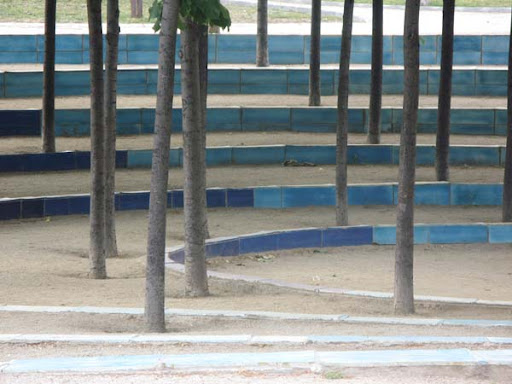30 November 2007
Mapping polluters
polluters are in your neighborhood.
28 November 2007
What a load of trash
 When I took this photo over the Meadowlands, I saw a landfill. But now, years later, I see a powerplant.
When I took this photo over the Meadowlands, I saw a landfill. But now, years later, I see a powerplant.A team of scientists here at the New Jersey Agriculture Experiment Station worked on a NJ Board of Public Utilities project to study the potential for biomass as an energy source across the state. Since garbage and landfill gas are both part of the equation, NJ has some pretty rich resources to tap. At the end of this initial study we found that NJ's total biomass resources could light about a million homes. As quoted in the papers:
"For the first time, we have an extremely detailed understanding of our bioenergy capabilities," said Margaret Brennan, who directed the biomass study for the Rutgers New Jersey Agricultural Experiment Station. "This gives us something to strive for. Before, we didn't know what the potential was."The project has an NJAES page now and is a pretty good place to start. It has the bioenergy calculator and basic project info.
The final report is big and grand. But the highlights are Caroline's maps. At least I think so.
Pretty soon our landfills will start looking like model landscapes...
Common Lecture: Georgeen Theodore, Interboro Partners
Interboro Design

Allan Shearer described them as "One of those young, hip urban design firms".
She started with:
In the Meantime, Life With Landbanking (e.g., PDF)
which looked at the "dead mall" phenomenon with a case study of the Dutchess Mall.
Interboro's methodology works around three rules:
- Detective work - do you know the problem?
- Ghostwriter - Identify people on the ground who need someone to sing their life.
- Life Coach - entails advocating for a person or place, advocating for a specific solution or outcome
You can see one of the areas she talked about here on Google Maps.
The final project was The Critical Path, set in Columbus, OH. This was their winning entry in Columbus Re-Wired. As an example of how their vision would work, they re-worked an area in NW Columbus without displacing anyone.
Georgeen mentioned Paul Davidoff in contrasting the old advocacy with the new work they are pursuing.
The Most Famous Tulloch
It used to be Lieutenant Colonel Tulloch, of the U. S. Army Corps of Engineers Baltimore District. The (in)famous wetlands Tulloch Rule was named after him and specified how excavations would be treated as opposed to just the dredging and filling under the Corps' 404 duties. Since it was first created in the early 1990s, there has been a Federal court ruling overturning it (in the late 1990s) and now there is a new Tulloch II rule established by EPA and COE. And I trust that wetlands advocates and home builders will help keep the Tulloch name alive in the courts for years to come.
But now, ruining everything for Lt. Col. Tulloch, comes along an actress named Bitsie. after some other minor roles, Bitsie Tulloch is starring in quarterlife which is an online tv show which has been picked up by NBC for wider broadcast. NY Magazine's headline captures it well, "Quarterlife's Bitsie Tulloch on Her Role as the World's First Attractive Blogger."

Cool class: 20th Century Architecture
27 November 2007
Data visualization videos
Piping plovers closing beaches
Efforts to protect the birds have led to closed beaches, canceled fireworks, lawsuits, warnings to cat owners and shelters to not release the animals near the shoreline and closed trails for all-terrain vehicles.
“When I first started this job almost 20 years ago it was really heated,” said Susi von Oettingen, an endangered species specialist with the federal Fish and Wildlife Service.
Maybe.
26 November 2007
Levittowns revisited
Today's Levittown, N.Y., is still only 10% nonwhite, but Willingboro, N.J., another Levittown development (in the Philadelphia suburbs), is now majority black. Indeed, more than one in four suburbanites nationwide is a minority-group member. Along with immigrants and their offspring, African-Americans have been consistently moving to the suburbs; the percentage of blacks living in the periphery has risen to well over one in three.
Changing architecture
.JPG) John Silber has written a book called Architecture of the Absurd in which he describes his complaints with contemporary (not Modern) architecture. In particular, this former president of Boston University seems equally upset with buildings where details fail (like Pei's John Hancock with windows that popped out and Gehry's Stata Center currently tied up in a lawsuit) and buildings that are deliberately designed in ways he can't comprehend (like Gehry's Stata Center and Holl's Simmons Hall, both at MIT). The Wall Street Journal reviewed the book recently:
John Silber has written a book called Architecture of the Absurd in which he describes his complaints with contemporary (not Modern) architecture. In particular, this former president of Boston University seems equally upset with buildings where details fail (like Pei's John Hancock with windows that popped out and Gehry's Stata Center currently tied up in a lawsuit) and buildings that are deliberately designed in ways he can't comprehend (like Gehry's Stata Center and Holl's Simmons Hall, both at MIT). The Wall Street Journal reviewed the book recently:A recurrent theme of Mr. Silber's is Genius architects' talent at verbal persuasion -- often a combination of jargon and bullying. For Mr. Silber, no one does it better than Frank Gehry, whose "misconception...that architecture has no distinct purpose or consequent limitations that distinguish it fundamentally from painting and sculpture has led him to impose on clients works that are profligate in cost and grotesquely unaccommodating to their purpose." Which brings us back to the Stata Center, "the pièce de résistance of absurdity in architecture."Silber seems especially interested in buildings in the Boston area. For instance, Sert's Peabody Center on the Charles. Based on the descriptions online, I suspect that I agree with his assessments of some individual buildings but would tend to disagree with his contempt for architects trying to achieve new and exciting things with their buildings. Practicality is probably underrated these days, but it isn't the only measure of success in design.
If reading isn't your thing, you can watch an interview about the book online.
(The photos is of Gehry's Weisman Art Museum at the University of Minnesota)
25 November 2007
A day beside the park


 This one was an art piece based on a smaller art piece by Jeff Koons.
This one was an art piece based on a smaller art piece by Jeff Koons. Just some fun photos from Turkey Day as a final respite before
Just some fun photos from Turkey Day as a final respite beforethe real work begins.
23 November 2007
Ten Crucial Days
Nouvel's MoMA
 Nice examples for or graphics studies.
Nice examples for or graphics studies.
21 November 2007
The SEC's South
When one person was about Tiger Stadium:
"Why is it so loud?" he asks as he stands outside the 92,000-seat colossus of a building. "It's the weight of the sky, the density of the air here. It's really louder than anywhere else. We have to blame the sky."
20 November 2007
Highlands Council disappoints
"Basically, what they've done tonight is gutted the whole Highlands Act," said Jeff Tittel, executive director of the New Jersey chapter of the Sierra Club, who was in the audience. "This plan's now about development and not about protecting water supply."There is no such thing as the "last word" on the Highlands, so just sit back and wait for the next twist.
In a lengthy statement preceding her vote, Pasquarelli said the plan now favors development and described it as "political pandering under the guise of environmental protection and growth management."
Ordnance Survey in Second LIfe
 CASA's Virtual London has been politely removed from Second Life out of respect for a request by the British Ordnance Survey. As the Digital Urban blog reports:
CASA's Virtual London has been politely removed from Second Life out of respect for a request by the British Ordnance Survey. As the Digital Urban blog reports:Details on the work currently unavailable are in the post below, we are reserving comment at request on this one, but i guess you know our views...Since I have never met Andy I can only guess that this is a very polite British way of saying that the Queen's rules on mapping are a tad bit crazy and oppressive. I have never fully grasped the rather extreme British system, but always thought it was just because I was an American, on the outside. This little episode reveals more fully the extremes to which this system continues to prevail upon the GIS community, even in a metaverse.
Artifical Momma owl
19 November 2007
Defiant Gardens Dot Com
 Kenny Helphand has sent out word that, by popular demand, he has created a Defiant Gardens blog/site. I can't say that I am surprised. The posts I have mentioning his book and appearance here at Rutgers have continued to get unusually high visitation rates. And, I see how popular his appearances have been elsewhere. Defiant Gardens has remained one of the best recent publications in the field. And the information he is posting is new and will energize many readers.
Kenny Helphand has sent out word that, by popular demand, he has created a Defiant Gardens blog/site. I can't say that I am surprised. The posts I have mentioning his book and appearance here at Rutgers have continued to get unusually high visitation rates. And, I see how popular his appearances have been elsewhere. Defiant Gardens has remained one of the best recent publications in the field. And the information he is posting is new and will energize many readers.
18 November 2007
Ken McCown visits IIT


Vernal Pools in the Highlands

Potential changes in development policies are seen by some to be threatening the vernal pools of the Highlands. CRSSA has been active in explaining vernal pool habitat loss and mapping out the locations of pools. But it isn't as if the Council member don't recognize the potential harm, the debate seems to be centering more on the costs of these policies:
Even if the policies change it doesn't mean that the debate will end. This is a fundamental tension between property rights, development pressures, societal valuing of wildlife, and concerns over environmental quality."I'm concerned with the logic of why, as a matter of policy, we would allow the exacerbation of water deficits," said member Tim Dillingham. "We should be very, very prudent in the watersheds we know are in a deficit."
"We have to do the right thing here," said Jack Schrier, the council's vice chair from Mendham Township. "If we are going to prohibit flat out any more depletive uses, we are essentially stopping all development. I don't think that's our purpose."
17 November 2007
Trees of Toronto
16 November 2007
GPS as an employee surveillance tool
But others worry about this as an intrusive tool that has the potential to violate the privacy of employees.Barton said Delaware paid $425 per unit for the GPS devices, as well as $24.99 a month per vehicle for tracking services. Information from each car is sent back to a central location, where things like fuel consumption and speed are recorded. He estimated the investment will be recouped in 3 1/2 years.
"If we're getting fuel reduction, less accidents and have our people slowing down, it more than pays for itself," Barton said.
The use of GPS has led to firings, stoking complaints from employees and unions that the devices are intrusive, Big Brother technology. But city officials say that monitoring employees' movements has deterred abuses, saving the taxpayers money in gasoline and lost productivity.In 3 months Islip saved 14,000 gallons of gas. Does it matter if it was because of more efficient routing or because employees stopped using public vehicles for driving to Michigan?
Video games changing the environment?
 Andrew Revkin writes, on the NY Times' Earth Dot Blog, about how some new video games might actually change the way that people see the environment. For instance, the new SimCity forces players to recognize the tradeoffs that happen when we simply don't have enough power, coal appears cheap and dirty, and solar isn't well developed. It leads Revkin to ask, could these games surpass Inconvenient Truth in overall impact.
Andrew Revkin writes, on the NY Times' Earth Dot Blog, about how some new video games might actually change the way that people see the environment. For instance, the new SimCity forces players to recognize the tradeoffs that happen when we simply don't have enough power, coal appears cheap and dirty, and solar isn't well developed. It leads Revkin to ask, could these games surpass Inconvenient Truth in overall impact.
15 November 2007
2 GIS jobs in Hunterdon County
GIS SPECIALIST III
ABILITIES Extensive knowledge of and experience with ESRI (Environmental Systems Research Institute) products ArcInfo, ArcView, ArcMAP, ArcCatalog as well as Trimble GPS equipment. Knowledge of and experience in computerized data entry and formatting, data base management, and data base utilization. Ability to maintain your focus on long-term work assignments. Knowledge of all phases of computer map preparation including digitization, data transmission, data reformatting, and map production. Experience with Trimble GPS products and software including data dictionary development, GPS data collection, correction and export. Knowledge of and experience in Metadata creation.
Knowledge of ESRI products Spatial Analyst, 3D Analyst, ArcIMS and ArcSDE, Visual Basic Scripting as well as Microsoft SQL Server and Adobe Illustrator a plus.
EDUCATION Graduation from an accredited college or university with a Bachelor's degree.
EXPERIENCE Two (2) years of experience with geographic information systems including computer graphics and computer hardware digitizing procedures, focusing on spatial data development and maintenance. Experience in reading and evaluating land surveys a plus.
NOTE: A Master's degree in Geography, or Environmental Science may be substituted for one (1) year of the indicated experience.
NOTE: Applicants who do not possess the required education may substitute additional experience as indicated on a year-for- year basis.
NOTE: A specific Bachelor's degree in Geography, Environmental Science or related field with twelve (12) semester hours in computer mapping/GIS which shall have included spatial programming and digital image processing may be substituted for one (1) year of the above experience.
LICENSE Appointees will be required to possess a driver's license valid in New Jersey.
Please submit a resume and a County Application for Employment to:
Hunterdon County Department of Human Resources
Cheryl A. Wieder, Director
Huntedon County Human Resources
PO Box 2900
Flemington, New Jersey 08822-2900
908-788-1114 * FAX 908-806-4236
AN EQUAL OPPORTUNITY EMPLOYER
ABILITIES Knowledge of and experience with ESRI (Environmental Systems Research Institute) products ArcInfo, ArcPlot, ArcEdit and ArcView as well as Trimble GPS equipment. Knowledge of Windows NT Operating System. Knowledge of computerized data entry and formatting, data base management, and data base utilization. Ability to develop effective work methods. Knowledge of all phases of computer map preparation including digitization, data transmission, data reformatting, and map production. A successful candidate will have the ability to work with diverse agencies and departments in determining, coordinating and developing GIS data sets, goals and activities.
Knowledge of ESRI products Spatial Analyst, 3D Analyst, Arc CAD and Map Objects as well as Microsoft SQL Server and Adobe Illustrator a plus.
Salary Range: $28,340 – $41,050
Please submit a resume and a County Application for Employment to:
Hunterdon County Department of Human Resources
Cheryl A. Wieder, Director
Huntedon County Human Resources
PO Box 2900
Flemington, New Jersey 08822-2900
908-788-1114 * FAX 908-806-4236
Vietnam Veterans Memorial Visitors Center

The Vietnam Veterans Memorial turned 25 this week and has some wondering about a proposed Visitors Center. US News and World Report mentions the new controversy but also revisits the old.

14 November 2007
Big Change in NJ Affordable Housing Law?
According to the state, 120 suburban towns have paid $210 million to 53 cities since 1988. The cities use the money to provide affordable housing. For instance, Colts Neck recently agreed to pay Long Branch $2.83 million to repair and develop 107 homes for low-income residents.Builder online reports more fully of the Democrats' 12 point plan.
Happy GIS Day
While you could celebrate by making a digital map product, you might settle for visiting a GIS Day event near you, or just checking out the GIS Day website.
12 November 2007
LA Times: Did succulents save her home?
Their garden of aloes, agaves, euphorbias and more -- created by Suzy with the help of San Diego landscape architect Robert Dean -- encircles the Southwest-style home, which is adjacent to a palm- and eucalyptus-filled canyon. The garden is intact, but many of the canyon's trees are blackened skeletons.
Land Use Change and Riparian Buffer Zone Status in the Barnegat Bay Watershed

From the PRESS RELEASE
Rutgers Center Assesses Land Use Change and Riparian Buffer Zone Status in the Barnegat Bay Watershed
New Brunswick, NJ--The Grant F. Walton Center for Remote Sensing & Spatial Analysis (CRSSA) at Rutgers has completed a project to assess recent land use change in the Barnegat Bay watershed. The updated mapping reveals that urban land use increased from approximately 25 percent in 1995 to approximately 30 percent of the watershed in 2006. Including all altered land uses (i.e., agriculture and barren lands) puts the percentage of altered land in the watershed at over 33 percent in 2006.
"The Barnegat Bay estuary system is continuing to experience a significant conversion of forested and wetland habitats to urban land cover and thereby exacerbating nutrient loading to the estuary," said Richard Lathrop, director of CRSSA. "The Barnegat Bay Estuary Program has identified the protection of riparian buffers as vital to meeting the goals of water quality and habitat protection within the Barnegat Bay watershed."
Riparian zones may constitute the immediate buffer to a stream as well as areas that may be more physically distant but are connected through groundwater flow, such as when wetlands are in close proximity to a stream. Protected riparian buffer zones adjacent to water bodies and streams, where human development and agriculture is excluded or minimized, is advocated as a "best management practice" to reduce the impact of human developed land uses on adjacent aquatic ecosystems and downstream water quality.
"Unfortunately," said Lathrop, "our assessment shows that between 1995 and 2006, approximately 1,920 acres of riparian habitat were developed. The northern portion of the Barnegat Bay watershed, which encompasses the Metedeconk, Beaver Dam, Kettle Creek and Silver Bay sub-basins, was especially hard hit with greater than 20 percent of the riparian zone being altered for land development."
On the positive side, the study identified approximately 1,300 acres of barren land and 677 acres of agricultural land within the mapped riparian zones that could serve as potential targets for re-vegetation and restoration.
Funding for the project was provided by the Barnegat Bay National Estuary Program. To access a copy of the full report go to http://crssa.rutgers.edu/projects/coastal/riparian.
CRSSA is a research center of the Rutgers School of Environmental and Biological Sciences.
What do you do when memorials get old?
11 November 2007
Great images of Paris Exposition of 1900
 A very nice collection of postcard photos from the 1900 Paris Exposition Universelle is available online. (You can buy posters of the photos, too.) It is amazing to see how many lasting structures were built, like the Alexander III Bridge, Gare d'Orsay, and the Grand Palais.
A very nice collection of postcard photos from the 1900 Paris Exposition Universelle is available online. (You can buy posters of the photos, too.) It is amazing to see how many lasting structures were built, like the Alexander III Bridge, Gare d'Orsay, and the Grand Palais.
And they all moved up
To me, the close clustering of UW, RU and UK shows how much could still change in the next couple of weeks.
09 November 2007
EPA Design competition
Horticultural Heroes
08 November 2007
Environmental Geomatics/GIS position
http://www.neiwpcc.org/employment/neiwpccopenings.asp
Deadline has been extended to November 16, 2007.
Information Officer
(GIS/Data Manager - Hudson River Estuary Program)
The New England Interstate Water Pollution Control Commission (NEIWPCC) is seeking an information specialist with experience in database design and management to manage GIS and other data, perform analyses on a wide variety of datasets and to develop methods for synthesis of data to derive projects, maps and tools for outreach programs. Position located in Albany, NY. The successful candidate will hold a BS degree in mathematics, information or computer science, engineering or related field, with work experience in database design and management. Experience using ArcGIS 9.1/9.2 to create, edit, analyze and maintain spatial data. Submit application, including cover letter, resume and writing sample.
More lessons for professional practice classes

Other reports on the Gehry/MIT lawsuit reach beyond the building and into the landscape. The contractor is claiming that they tried not to build the amphitheater (pictured above) this way:
I am sure that all parties will produce reams and reams of data before this is over. This could turn into a lesson for Pro Practice classes for decades to come; we just have to learn what that lesson is first.An executive at Skanska's Boston office yesterday blamed Gehry for problems with the project and said Gehry ignored warnings from Skanska and a consulting company prior to construction that there were flaws in his design of the amphitheater.
"This is not a construction issue, never has been," said Paul Hewins, executive vice president and area general manager of Skanska USA. He said Gehry rejected Skanska's formal request to create a design that included soft joints and a drainage system in the amphitheater, and "we were told to proceed with the original design."
After the amphitheater began cracking and flooding, Skanska spent "a few hundred thousand dollars" trying to resolve the problems, but, he said, "it was difficult to make the original design work."
Sagarin update in a slow week
06 November 2007
MIT is suing Frank Gehry
 The NY Times is reporting that MIT has filed a lawsuit against Frank Gehry for his Stata Center. No, not because of how the building looks or what it has done to their campus image. Instead, it is because they feel he inadequately accounted for the water and snow and mold.
The NY Times is reporting that MIT has filed a lawsuit against Frank Gehry for his Stata Center. No, not because of how the building looks or what it has done to their campus image. Instead, it is because they feel he inadequately accounted for the water and snow and mold.
05 November 2007
Is the Kentlands really working?
Moynihan Station is moving ahead
 The replacement for the replacement for Pennsylvania Station is moving ahead, slowly. Called Moynihan Station, the plans for moving into the Old Post Office are being revived and, as the New York Times writes, it is not going to be easy to make something grand and meaningful. Among other things, the Times asks for a greater separation of MSG and Penn:
The replacement for the replacement for Pennsylvania Station is moving ahead, slowly. Called Moynihan Station, the plans for moving into the Old Post Office are being revived and, as the New York Times writes, it is not going to be easy to make something grand and meaningful. Among other things, the Times asks for a greater separation of MSG and Penn:Finally, the Beaux-Arts stairs and columns on the front of the old Farley post office cannot become primarily an entrance to the Garden — or a bulletin board to hawk Garden events. This is no ordinary building. Built to complement the old Pennsylvania Station, torn down 44 years ago, the Farley is a public treasure that must be preserved. The last thing New York needs is another dreadful Pennsylvania Station that only serves developers and Madison Square Garden.

03 November 2007
Missing Barcelona
01 November 2007
Cool Class: Environmental Issues in the US
Frank Gallagher's 11:372:202 Environmental Issues in the US.
The photos on the class site are great.
Neutra's Kaufmann House goes up for auction
Still, such sales sometimes draw criticism from preservationists who would prefer that the houses be tended by a public institution or trust that guarantees continued access for architecture students and scholars rather than sold to the highest bidder. (The Farnsworth House, now open to the public, was bought by the National Trust for Historic Preservation, while the Maison Tropicale went to a private bidder.)













